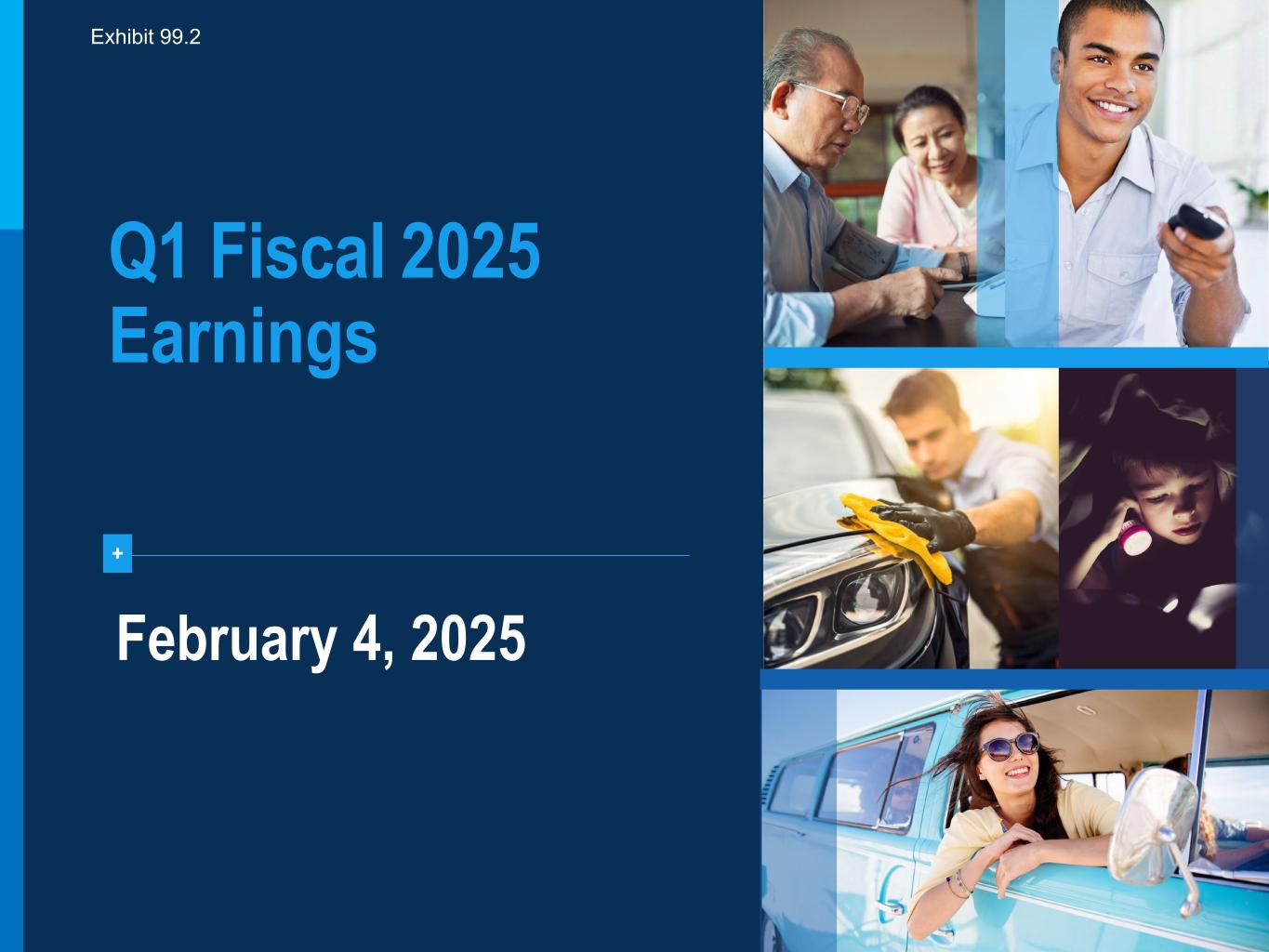
+ February 4, 2025 Q1 Fiscal 2025 Earnings Exhibit 99.2
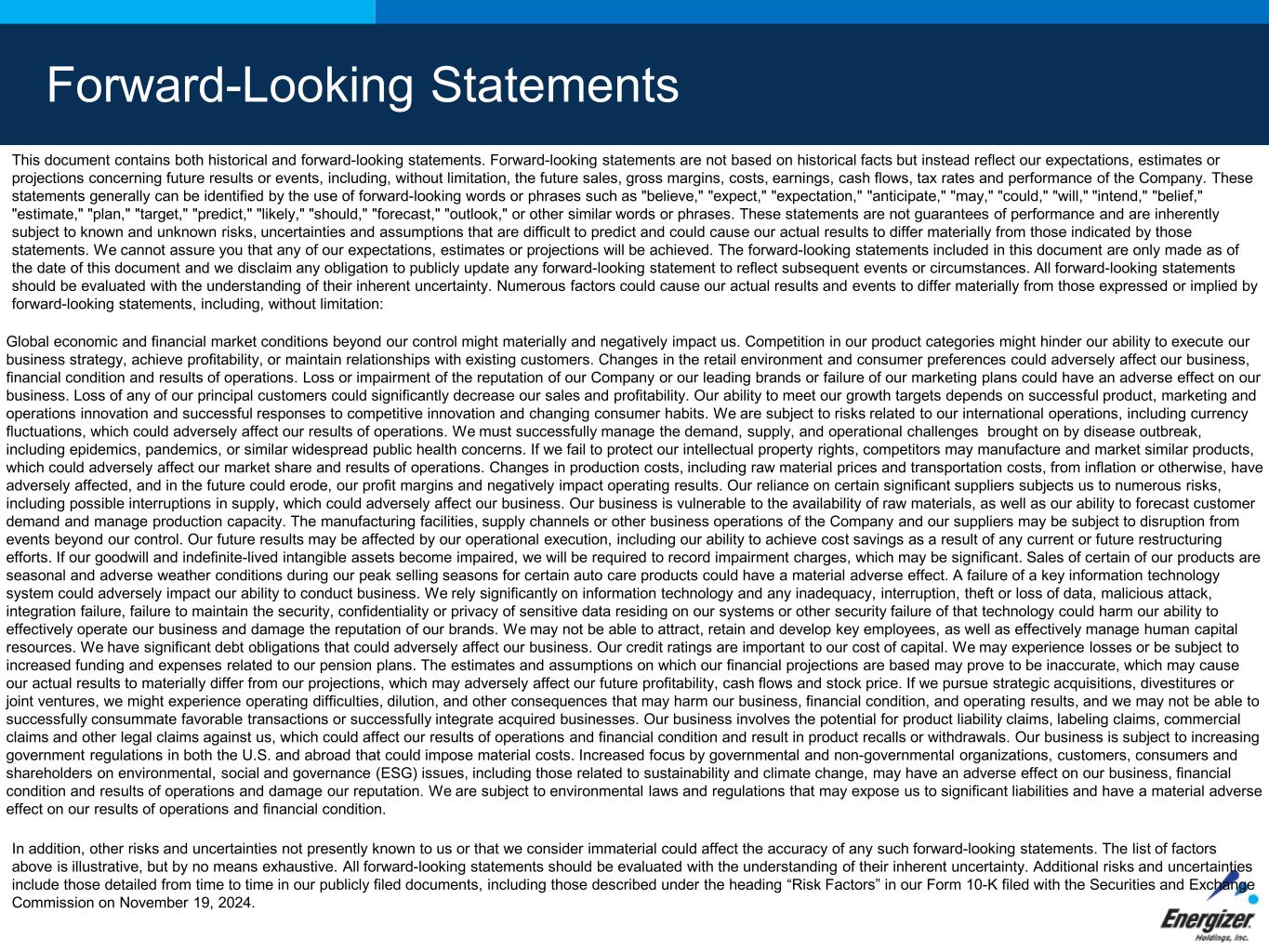
This document contains both historical and forward-looking statements. Forward-looking statements are not based on historical facts but instead reflect our expectations, estimates or projections concerning future results or events, including, without limitation, the future sales, gross margins, costs, earnings, cash flows, tax rates and performance of the Company. These statements generally can be identified by the use of forward-looking words or phrases such as "believe," "expect," "expectation," "anticipate," "may," "could," "will," "intend," "belief," "estimate," "plan," "target," "predict," "likely," "should," "forecast," "outlook," or other similar words or phrases. These statements are not guarantees of performance and are inherently subject to known and unknown risks, uncertainties and assumptions that are difficult to predict and could cause our actual results to differ materially from those indicated by those statements. We cannot assure you that any of our expectations, estimates or projections will be achieved. The forward-looking statements included in this document are only made as of the date of this document and we disclaim any obligation to publicly update any forward-looking statement to reflect subsequent events or circumstances. All forward-looking statements should be evaluated with the understanding of their inherent uncertainty. Numerous factors could cause our actual results and events to differ materially from those expressed or implied by forward-looking statements, including, without limitation: Global economic and financial market conditions beyond our control might materially and negatively impact us. Competition in our product categories might hinder our ability to execute our business strategy, achieve profitability, or maintain relationships with existing customers. Changes in the retail environment and consumer preferences could adversely affect our business, financial condition and results of operations. Loss or impairment of the reputation of our Company or our leading brands or failure of our marketing plans could have an adverse effect on our business. Loss of any of our principal customers could significantly decrease our sales and profitability. Our ability to meet our growth targets depends on successful product, marketing and operations innovation and successful responses to competitive innovation and changing consumer habits. We are subject to risks related to our international operations, including currency fluctuations, which could adversely affect our results of operations. We must successfully manage the demand, supply, and operational challenges brought on by disease outbreak, including epidemics, pandemics, or similar widespread public health concerns. If we fail to protect our intellectual property rights, competitors may manufacture and market similar products, which could adversely affect our market share and results of operations. Changes in production costs, including raw material prices and transportation costs, from inflation or otherwise, have adversely affected, and in the future could erode, our profit margins and negatively impact operating results. Our reliance on certain significant suppliers subjects us to numerous risks, including possible interruptions in supply, which could adversely affect our business. Our business is vulnerable to the availability of raw materials, as well as our ability to forecast customer demand and manage production capacity. The manufacturing facilities, supply channels or other business operations of the Company and our suppliers may be subject to disruption from events beyond our control. Our future results may be affected by our operational execution, including our ability to achieve cost savings as a result of any current or future restructuring efforts. If our goodwill and indefinite-lived intangible assets become impaired, we will be required to record impairment charges, which may be significant. Sales of certain of our products are seasonal and adverse weather conditions during our peak selling seasons for certain auto care products could have a material adverse effect. A failure of a key information technology system could adversely impact our ability to conduct business. We rely significantly on information technology and any inadequacy, interruption, theft or loss of data, malicious attack, integration failure, failure to maintain the security, confidentiality or privacy of sensitive data residing on our systems or other security failure of that technology could harm our ability to effectively operate our business and damage the reputation of our brands. We may not be able to attract, retain and develop key employees, as well as effectively manage human capital resources. We have significant debt obligations that could adversely affect our business. Our credit ratings are important to our cost of capital. We may experience losses or be subject to increased funding and expenses related to our pension plans. The estimates and assumptions on which our financial projections are based may prove to be inaccurate, which may cause our actual results to materially differ from our projections, which may adversely affect our future profitability, cash flows and stock price. If we pursue strategic acquisitions, divestitures or joint ventures, we might experience operating difficulties, dilution, and other consequences that may harm our business, financial condition, and operating results, and we may not be able to successfully consummate favorable transactions or successfully integrate acquired businesses. Our business involves the potential for product liability claims, labeling claims, commercial claims and other legal claims against us, which could affect our results of operations and financial condition and result in product recalls or withdrawals. Our business is subject to increasing government regulations in both the U.S. and abroad that could impose material costs. Increased focus by governmental and non-governmental organizations, customers, consumers and shareholders on environmental, social and governance (ESG) issues, including those related to sustainability and climate change, may have an adverse effect on our business, financial condition and results of operations and damage our reputation. We are subject to environmental laws and regulations that may expose us to significant liabilities and have a material adverse effect on our results of operations and financial condition. In addition, other risks and uncertainties not presently known to us or that we consider immaterial could affect the accuracy of any such forward-looking statements. The list of factors above is illustrative, but by no means exhaustive. All forward-looking statements should be evaluated with the understanding of their inherent uncertainty. Additional risks and uncertainties include those detailed from time to time in our publicly filed documents, including those described under the heading “Risk Factors” in our Form 10-K filed with the Securities and Exchange Commission on November 19, 2024. Forward-Looking Statements
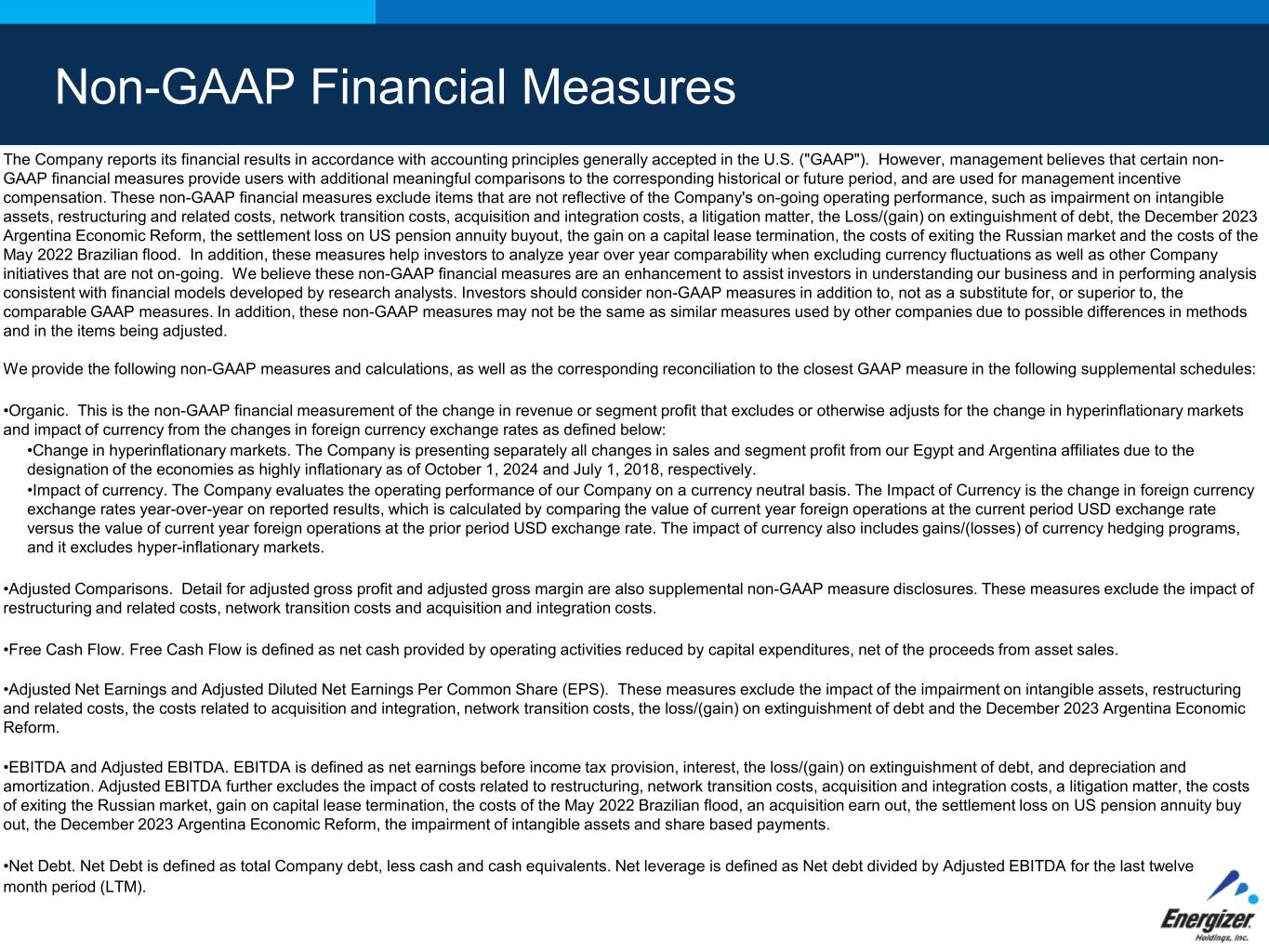
Non-GAAP Financial Measures The Company reports its financial results in accordance with accounting principles generally accepted in the U.S. ("GAAP"). However, management believes that certain non- GAAP financial measures provide users with additional meaningful comparisons to the corresponding historical or future period, and are used for management incentive compensation. These non-GAAP financial measures exclude items that are not reflective of the Company's on-going operating performance, such as impairment on intangible assets, restructuring and related costs, network transition costs, acquisition and integration costs, a litigation matter, the Loss/(gain) on extinguishment of debt, the December 2023 Argentina Economic Reform, the settlement loss on US pension annuity buyout, the gain on a capital lease termination, the costs of exiting the Russian market and the costs of the May 2022 Brazilian flood. In addition, these measures help investors to analyze year over year comparability when excluding currency fluctuations as well as other Company initiatives that are not on-going. We believe these non-GAAP financial measures are an enhancement to assist investors in understanding our business and in performing analysis consistent with financial models developed by research analysts. Investors should consider non-GAAP measures in addition to, not as a substitute for, or superior to, the comparable GAAP measures. In addition, these non-GAAP measures may not be the same as similar measures used by other companies due to possible differences in methods and in the items being adjusted. We provide the following non-GAAP measures and calculations, as well as the corresponding reconciliation to the closest GAAP measure in the following supplemental schedules: •Organic. This is the non-GAAP financial measurement of the change in revenue or segment profit that excludes or otherwise adjusts for the change in hyperinflationary markets and impact of currency from the changes in foreign currency exchange rates as defined below: •Change in hyperinflationary markets. The Company is presenting separately all changes in sales and segment profit from our Egypt and Argentina affiliates due to the designation of the economies as highly inflationary as of October 1, 2024 and July 1, 2018, respectively. •Impact of currency. The Company evaluates the operating performance of our Company on a currency neutral basis. The Impact of Currency is the change in foreign currency exchange rates year-over-year on reported results, which is calculated by comparing the value of current year foreign operations at the current period USD exchange rate versus the value of current year foreign operations at the prior period USD exchange rate. The impact of currency also includes gains/(losses) of currency hedging programs, and it excludes hyper-inflationary markets. •Adjusted Comparisons. Detail for adjusted gross profit and adjusted gross margin are also supplemental non-GAAP measure disclosures. These measures exclude the impact of restructuring and related costs, network transition costs and acquisition and integration costs. •Free Cash Flow. Free Cash Flow is defined as net cash provided by operating activities reduced by capital expenditures, net of the proceeds from asset sales. •Adjusted Net Earnings and Adjusted Diluted Net Earnings Per Common Share (EPS). These measures exclude the impact of the impairment on intangible assets, restructuring and related costs, the costs related to acquisition and integration, network transition costs, the loss/(gain) on extinguishment of debt and the December 2023 Argentina Economic Reform. •EBITDA and Adjusted EBITDA. EBITDA is defined as net earnings before income tax provision, interest, the loss/(gain) on extinguishment of debt, and depreciation and amortization. Adjusted EBITDA further excludes the impact of costs related to restructuring, network transition costs, acquisition and integration costs, a litigation matter, the costs of exiting the Russian market, gain on capital lease termination, the costs of the May 2022 Brazilian flood, an acquisition earn out, the settlement loss on US pension annuity buy out, the December 2023 Argentina Economic Reform, the impairment of intangible assets and share based payments. •Net Debt. Net Debt is defined as total Company debt, less cash and cash equivalents. Net leverage is defined as Net debt divided by Adjusted EBITDA for the last twelve month period (LTM).

+ Financial Results Q1 Fiscal 2025
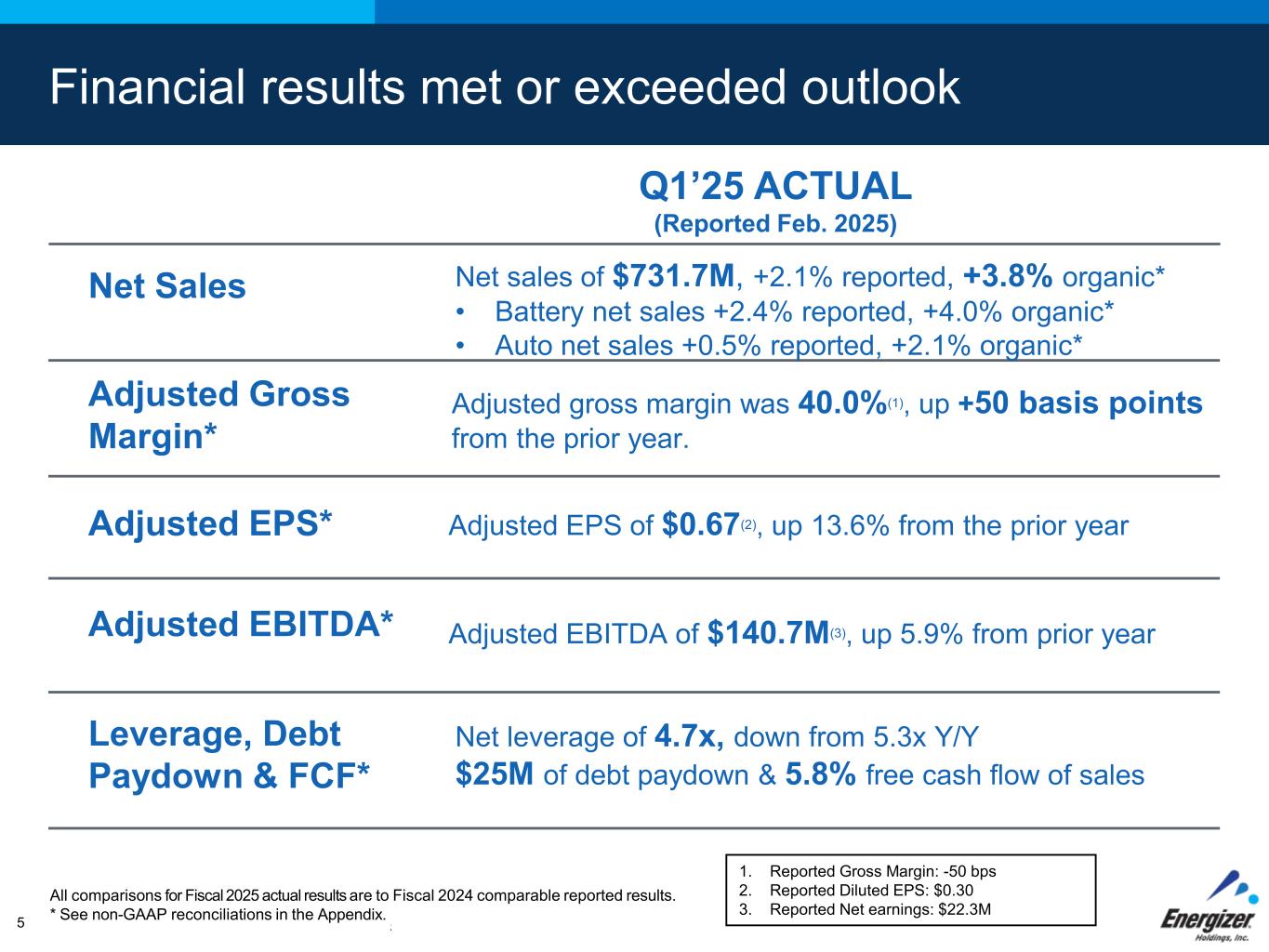
FOR INTERNAL USE ONLY – DO NOT DISTRIBUTE Financial results met or exceeded outlook Q1’25 ACTUAL (Reported Feb. 2025) 5 All comparisons for Fiscal 2025 actual results are to Fiscal 2024 comparable reported results. * See non-GAAP reconciliations in the Appendix. 1. Reported Gross Margin: -50 bps 2. Reported Diluted EPS: $0.30 3. Reported Net earnings: $22.3M Net sales of $731.7M, +2.1% reported, +3.8% organic* • Battery net sales +2.4% reported, +4.0% organic* • Auto net sales +0.5% reported, +2.1% organic* Adjusted gross margin was 40.0%(1), up +50 basis points from the prior year. Adjusted EPS of $0.67(2), up 13.6% from the prior year Adjusted EBITDA of $140.7M(3), up 5.9% from prior year Net leverage of 4.7x, down from 5.3x Y/Y $25M of debt paydown & 5.8% free cash flow of sales Net Sales Adjusted Gross Margin* Adjusted EPS* Adjusted EBITDA* Leverage, Debt Paydown & FCF*
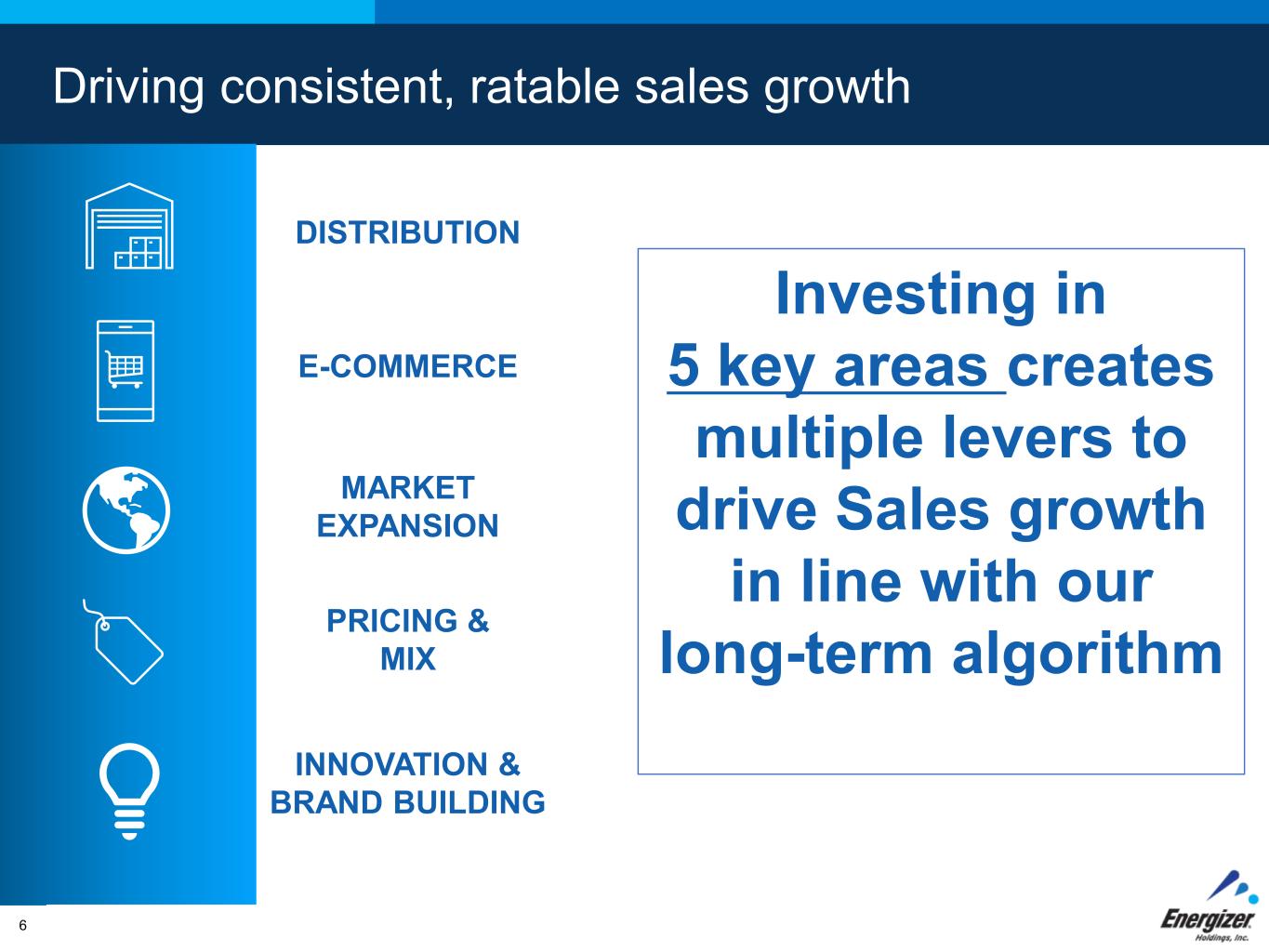
FOR INTERNAL USE ONLY – DO NOT DISTRIBUTE Driving consistent, ratable sales growth PRICING & MIX MARKET EXPANSION E-COMMERCE DISTRIBUTION 6 INNOVATION & BRAND BUILDING Investing in 5 key areas creates multiple levers to drive Sales growth in line with our long-term algorithm levers to drive Sales growth in line with our long-term algorithm

FOR INTERNAL USE ONLY – DO NOT DISTRIBUTE Continued debt & leverage reduction 7 6.1x 5.8x 5.2x 4.9x 4.7x ~4.5x 3.0x 4.0x 5.0x 6.0x 7.0x $1.5 $2.0 $2.5 $3.0 $3.5 FY'22 Q3 FY'22 FY'23 FY'24 FY'25 Q1 FY'25 Q4 Est. Net Debt & Net Leverage Net Debt ($B) Net Debt / Adj. EBTIDA* +$500 million of debt paydown since Q4 FY’22

+ Outlook Fiscal 2025 & Q2

FOR INTERNAL USE ONLY – DO NOT DISTRIBUTE Raising FY25 organic sales guidance & holding other key metrics Reported Net Sales Organic Net Sales Adjusted Gross Margin* Adjusted EPS* Adjusted EBITDA* +1% to +2% +1% to +2% +50bps $3.45 - $3.65 $625M - $645M +1% to +2% +2% to +3% No Change No Change No Change Prior FY’25 Outlook (Provided Nov. 2024) Updated FY’25 Outlook (Provided Feb. 2025) 9 All comparisons for Fiscal 2025 outlook are to Fiscal 2024 comparable reported results. * See non-GAAP reconciliations in the Appendix.
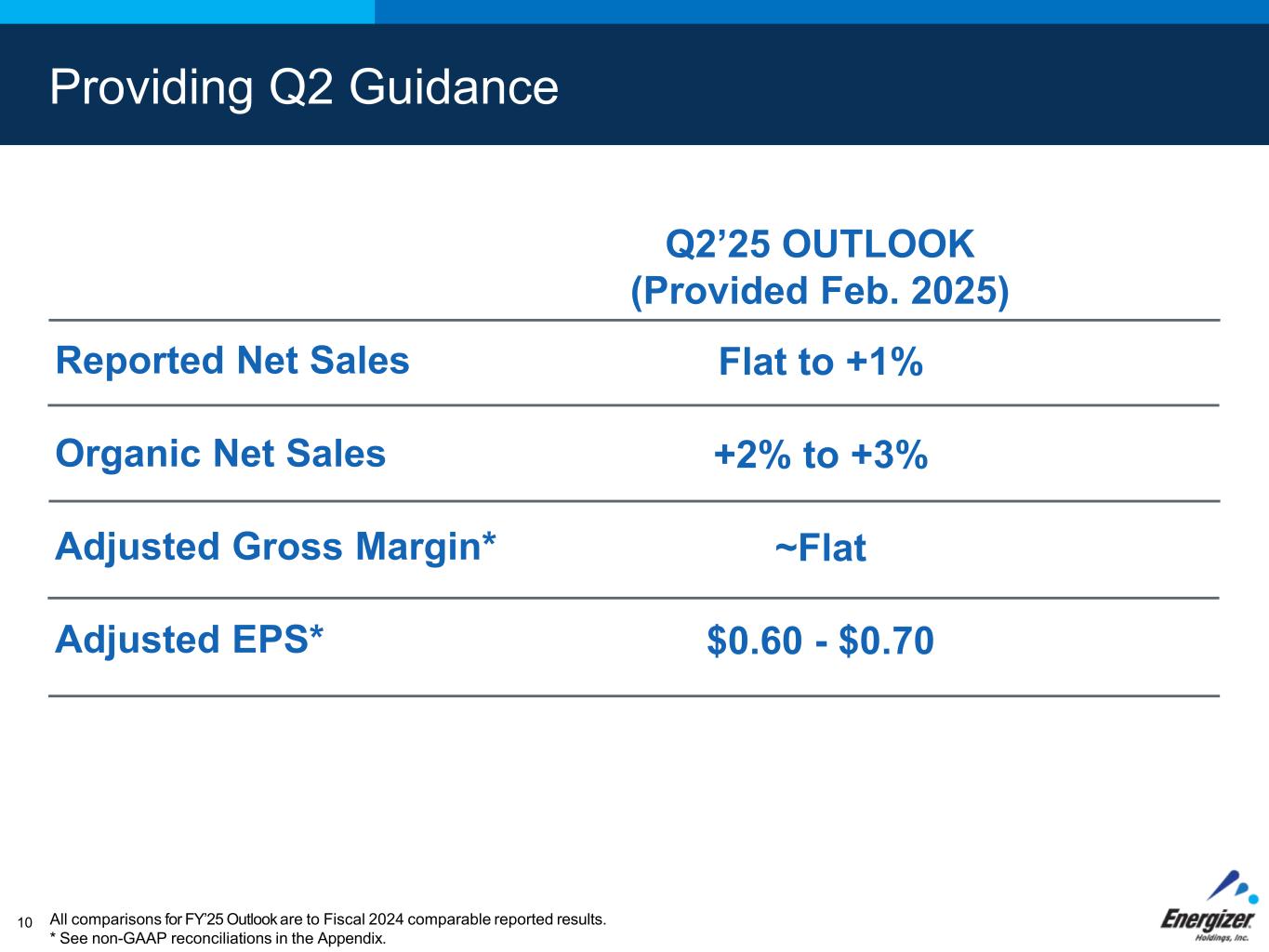
FOR INTERNAL USE ONLY – DO NOT DISTRIBUTE Providing Q2 Guidance Reported Net Sales Organic Net Sales Adjusted Gross Margin* Adjusted EPS* Flat to +1% +2% to +3% ~Flat $0.60 - $0.70 Q2’25 OUTLOOK (Provided Feb. 2025) 10 All comparisons for FY’25 Outlook are to Fiscal 2024 comparable reported results. * See non-GAAP reconciliations in the Appendix.
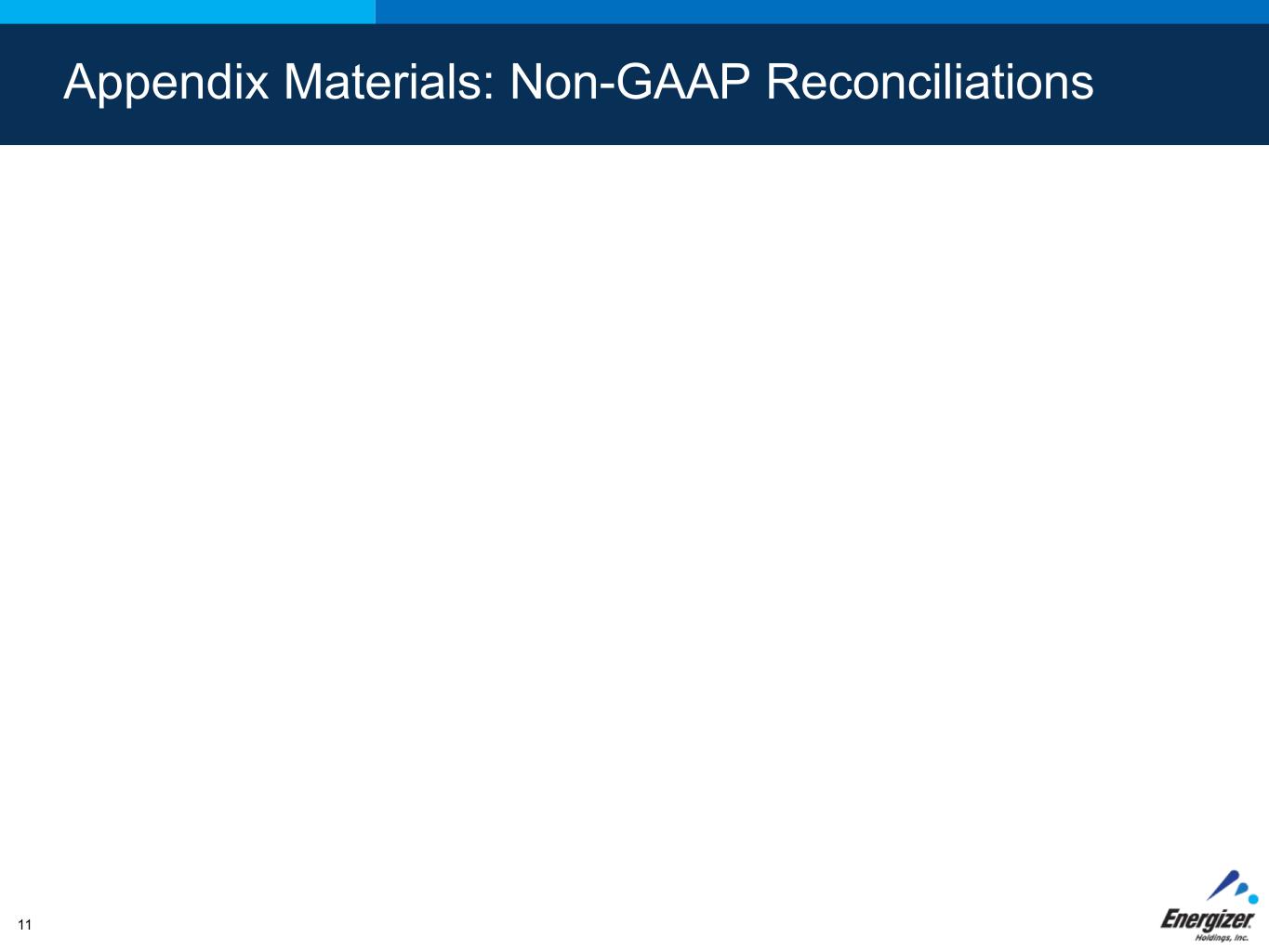
Appendix Materials: Non-GAAP Reconciliations 11

Non-GAAP Reconciliation: Net Sales (in millions) Organic. This is the non-GAAP financial measurement of the change in revenue that excludes or otherwise adjusts for the change in hyperinflationary markets and impact of currency from the changes in foreign currency exchange rates as defined below: • Change in hyperinflationary markets. The Company is presenting separately all changes in sales and segment profit from our Egypt and Argentina affiliates due to the designation of the economies as highly inflationary as of October 1, 2024 and July 1, 2018, respectively. • Impact of Currency. The Company evaluates the operating performance of our Company on a currency neutral basis. The Impact of Currency is the change in foreign currency exchange rates year-over-year on reported results, which is calculated by comparing the value of current year foreign operations at the current period USD exchange rate versus the value of current year foreign operations at the prior period USD exchange rate. The impact of currency also includes gains/(losses) of currency hedging programs, and it excludes hyper-inflationary markets. 12

Non-GAAP Reconciliation: Adjusted Gross Margin (in millions) Adjusted gross margin as a percent of sales excludes any charges related to restructuring programs, network transition costs, and acquisition and integration. 13
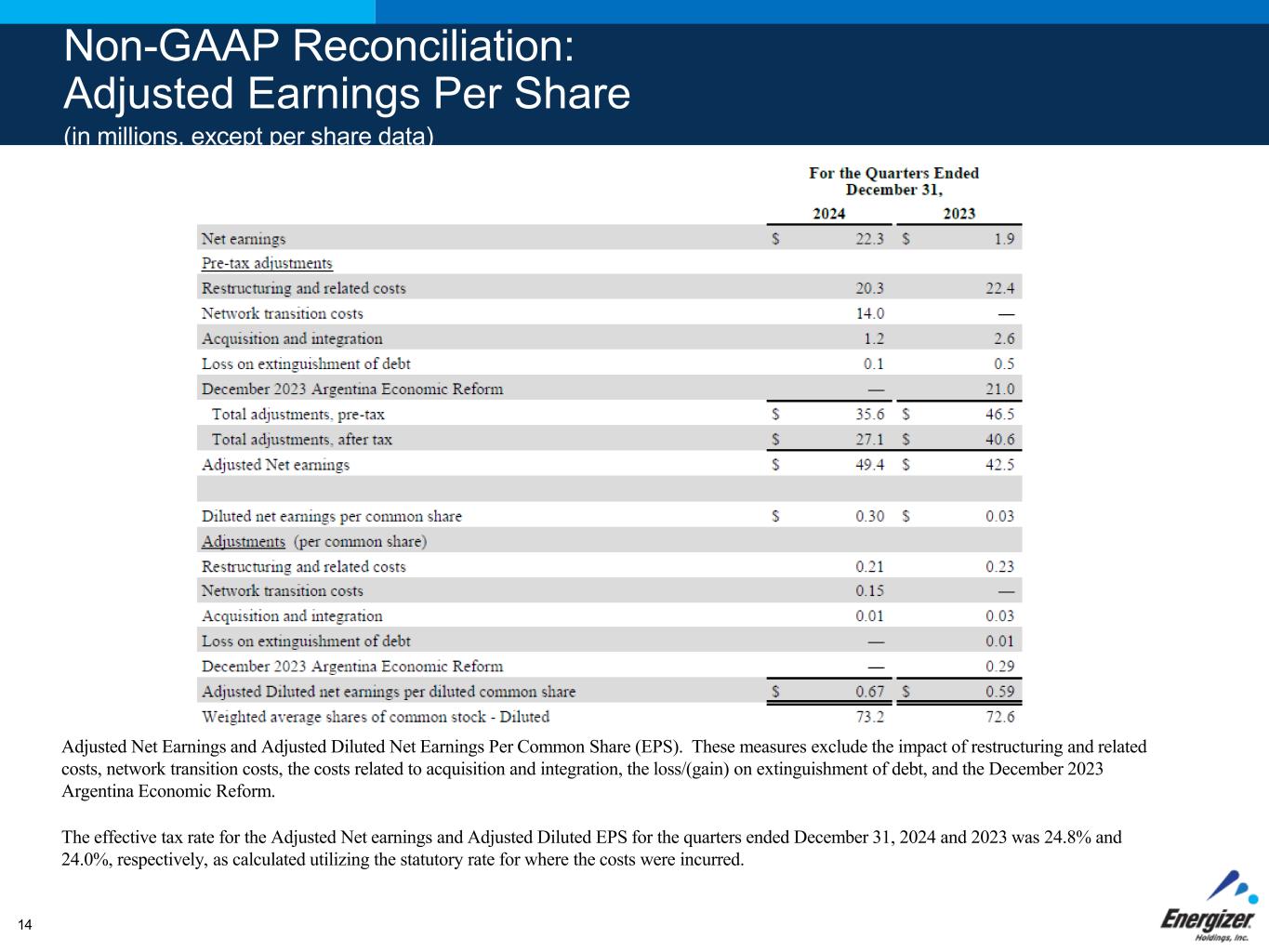
Non-GAAP Reconciliation: Adjusted Earnings Per Share (in millions, except per share data) Adjusted Net Earnings and Adjusted Diluted Net Earnings Per Common Share (EPS). These measures exclude the impact of restructuring and related costs, network transition costs, the costs related to acquisition and integration, the loss/(gain) on extinguishment of debt, and the December 2023 Argentina Economic Reform. The effective tax rate for the Adjusted Net earnings and Adjusted Diluted EPS for the quarters ended December 31, 2024 and 2023 was 24.8% and 24.0%, respectively, as calculated utilizing the statutory rate for where the costs were incurred. 14
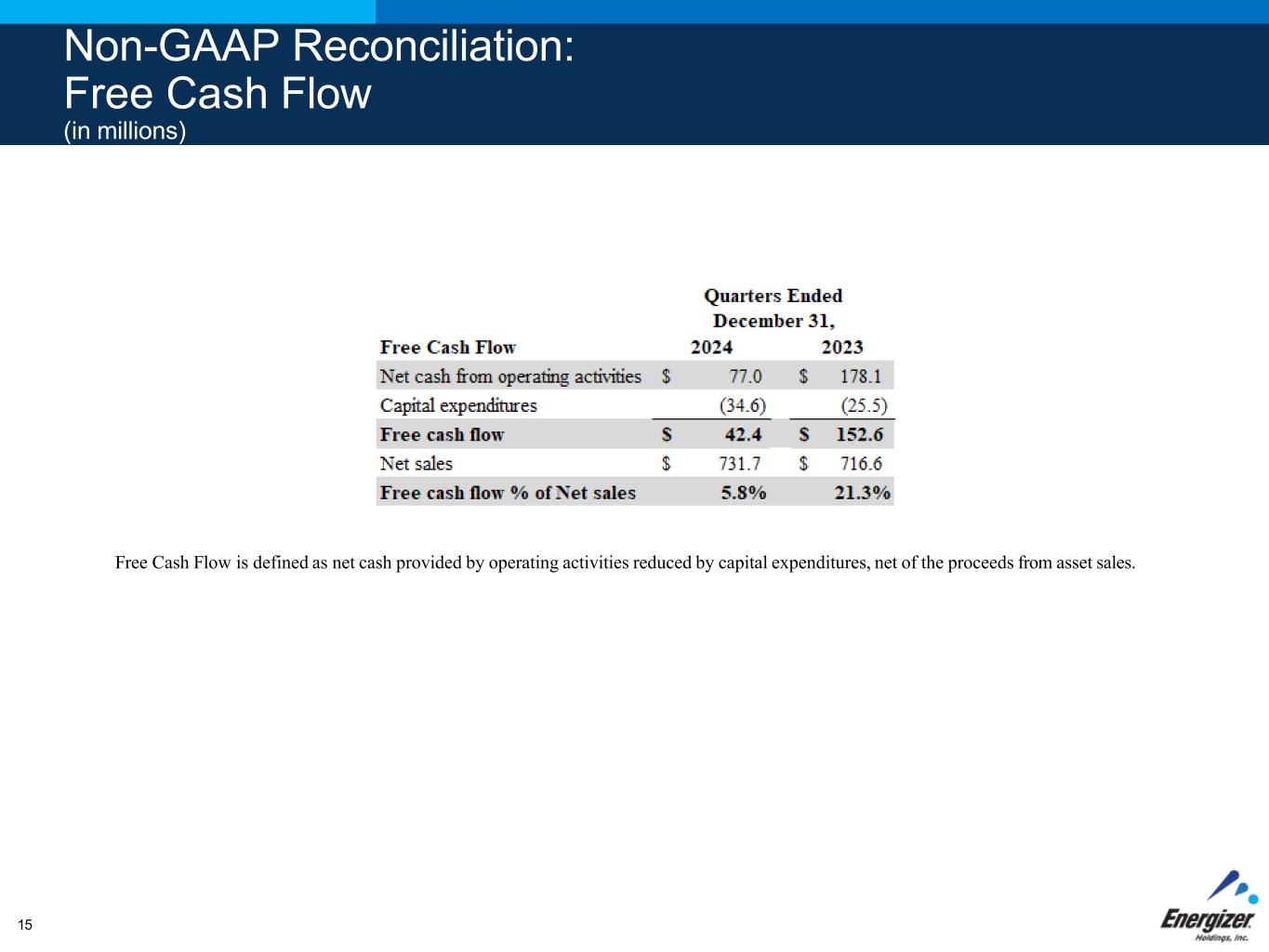
Non-GAAP Reconciliation: Free Cash Flow (in millions) Free Cash Flow is defined as net cash provided by operating activities reduced by capital expenditures, net of the proceeds from asset sales. 15
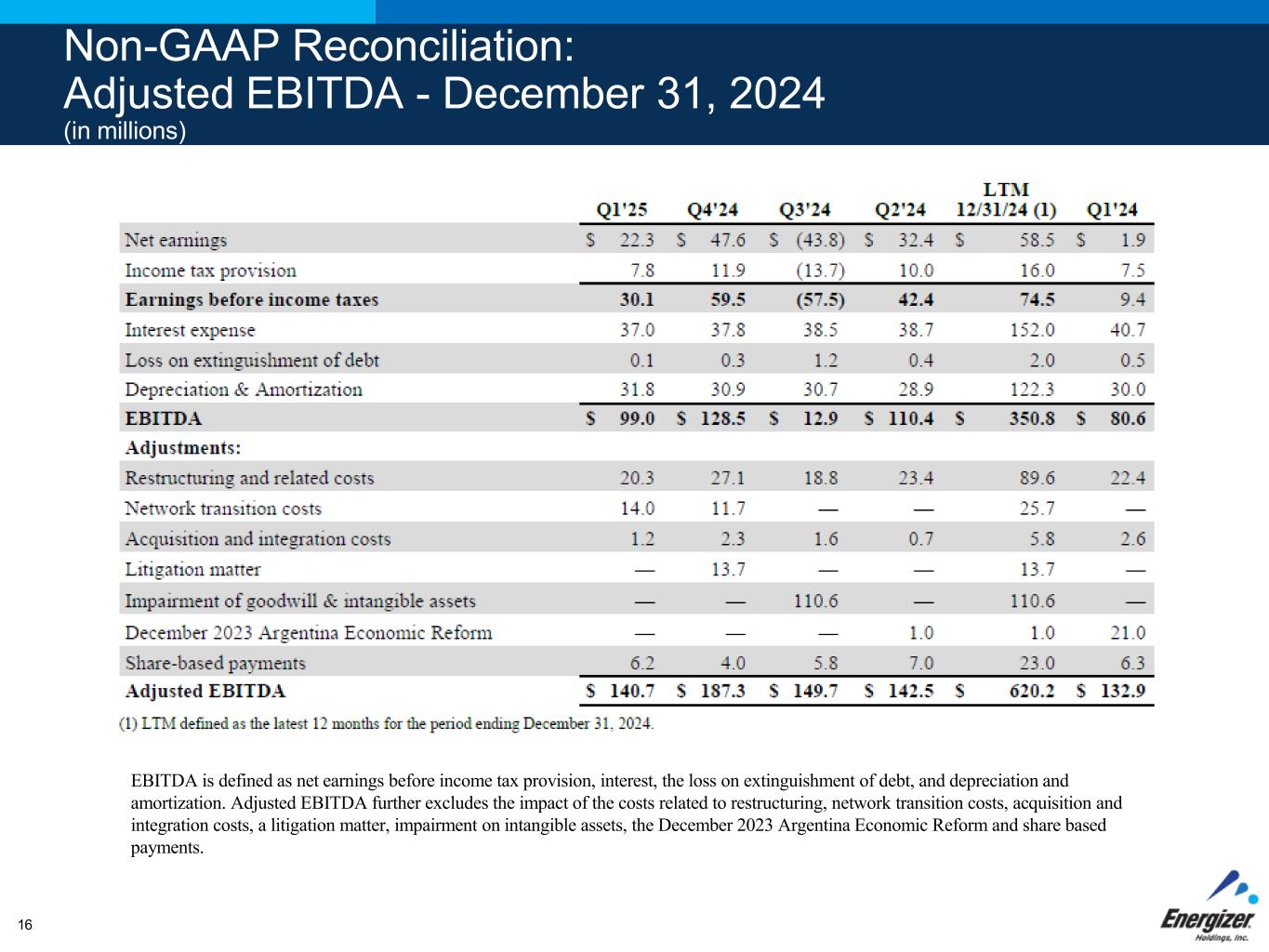
Non-GAAP Reconciliation: Adjusted EBITDA - December 31, 2024 (in millions) EBITDA is defined as net earnings before income tax provision, interest, the loss on extinguishment of debt, and depreciation and amortization. Adjusted EBITDA further excludes the impact of the costs related to restructuring, network transition costs, acquisition and integration costs, a litigation matter, impairment on intangible assets, the December 2023 Argentina Economic Reform and share based payments. 16

Non-GAAP Reconciliation: Adjusted EBITDA - Fiscal 2024 and 2023 (in millions) EBITDA is defined as net earnings before income tax provision, interest, the loss on extinguishment of debt, and depreciation and amortization. Adjusted EBITDA further excludes the impact of the costs related to restructuring, network transition costs, acquisition and integration costs, a litigation matter, the settlement loss on US pension annuity buy out, impairment on intangible assets, the December 2023 Argentina Economic Reform and share based payments. 17

Non-GAAP Reconciliation: Adjusted EBITDA - Fiscal 2022 (in millions) EBITDA is defined as net earnings before income tax provision, interest, the loss on extinguishment of debt, and depreciation and amortization. Adjusted EBITDA further excludes the impact of the costs related to restructuring, acquisition and integration costs, impairment on goodwill & intangible assets, the exit of Russian market, a gain on finance lease termination, an acquisition earnout, the impact from Brazil flood damage, net of insurance proceeds, and share based payments. 18

Non-GAAP Reconciliation: Adjusted EBITDA - June 30, 2022 (in millions) EBITDA is defined as net earnings before income tax provision, interest, the loss on extinguishment of debt, and depreciation and amortization. Adjusted EBITDA further excludes the impact of acquisition and integration costs, the costs of exiting the Russian market, Gain on capital lease termination, the loss from the May 2022 Brazil flood damage, an acquisition earn out and share based payments. 19

Non-GAAP Reconciliation: Net Debt and Net Leverage (in millions) Net Debt is defined as total Company debt, less cash and cash equivalents. Net leverage is Net debt divided by the last twelve months Adjusted EBITDA. LTM is the last twelve months for June 30, 2022, September 30, 2022, 2023, and 2024, and December 31, 2024, respectively. 20
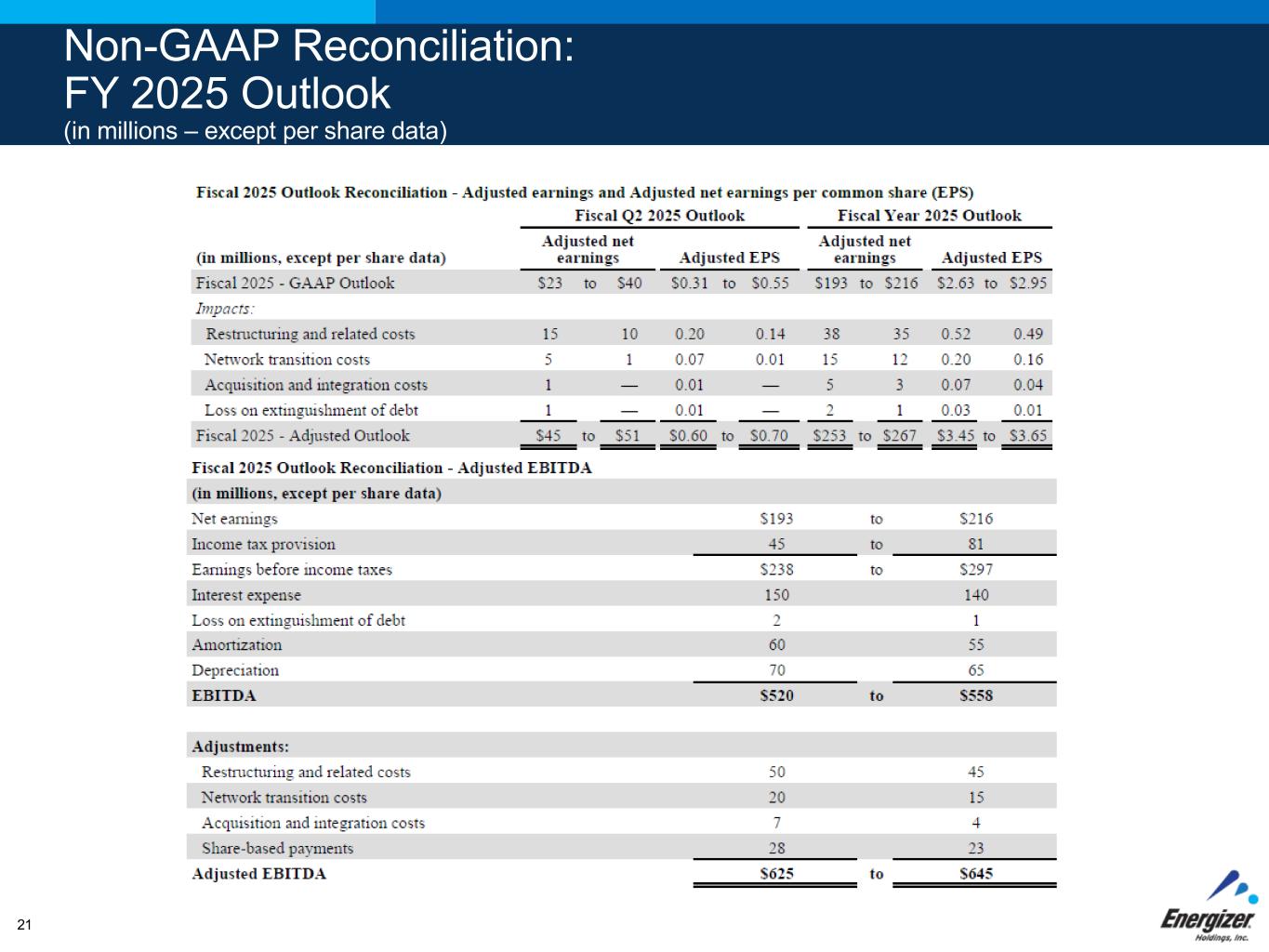
Non-GAAP Reconciliation: FY 2025 Outlook (in millions – except per share data) 21




















